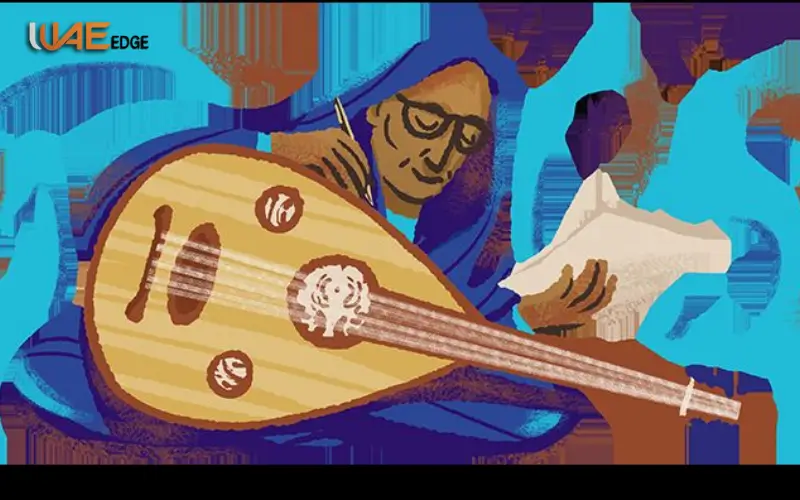Introduction
Music has always been a language of identity, feeling and togetherness. Asma Hamza is one of the giants amongst the voices that transformed this language in Sudan and elsewhere. She is considered to be the first woman music composer in Sudan and left her mark of bravery, imagination and talent in the sphere where arts were a male prerogative at that period of time.
Not only is her name celebrated in Sudan but it has also been appreciated in all the United Arab Emirates, where her work is appreciated by the already awakening awareness of women in culture and art. The story of Asma Hamza is the spirit of empowerment and creative development in the UAE: a country that has turned into the center of Arab music, art fests, and intercultural communication.
Early Life and Background
Khartoum, Roots: A Musical Soul Arises
Asma Hamza was born and brought up in Khartoum, Sudan where women were not allowed to participate in music. However, her domestic life was full of rhythm, melody and poetry. Her initial music interest was through listening to songs of the Sudanese folk, radio stations and Egyptian classical radio stations – especially the songs of the legendary Umm Kulthum.
Families and cultural upbringing
Her family was conservative and educated and language-conscious. Her home and school education got her an impression of the melodic character of Arabic poetry. Most girls were being taught how to master domestic arts, but Asma was attracted to the instruments, tones, and melodious harmony, something more than the Sudanese women of her time.
Her Youthful Cultural Situation
Asma was growing up in times when Sudan was struggling to redefine its national identity after gaining independence. The culture, which was traditional, came into conflict with the new modernity, and the role of women was strictly defined. In this context, the interest of Asma Hamza in composition symbolized silent resistance – an assertion that music is in both sexes, in the human soul per se.
Journey Into Music
Discovering Her Calling
Asma Hamza started learning the musical scales and the music structure with her ears despite the scarcity of resources and the absence of formal conservatory training available to women. She used to listen to songs over and over, and then dissect them into melodic elements and then try to reproduce similar sounds with her help using a simple oud, the classical string instrument of Arabic music.
Learning Without Guidance
She was self-driven and instinctive in her learning process. She was not mentored formally, but rather inspired by radio orchestras, poets of Sudan, and Egyptian composers like Mohammed Abdel Wahab. This initial experimentation rendered her responsive to tone, emotion, and rhythm – the means of her art at a later stage.
First Steps in Composition
The initial pieces of her composing were private; she played them to her close friends and family. The name Asma Hamza came into the limelight when one of her works was picked up by a local singer and subsequently played on Sudanese radio. Not only was it the name of the composer, but the composer was female which was almost unprecedented in Sudanese society.
Challenges, Problems and Cultural Resistance
The Social Stigma of Society and Gender Expectations
The career of Asma Hamza did not pass smoothly. The society in Sudan in the middle of the 20th century imposed strict moral limits on females in art in the society. Playing music could be viewed as indecent and creating music was something a woman could not even imagine.
Breaking Stereotypes
Asma continued to disregard criticism and was locked out of some musical communities. Her silent rebellion encouraged other women to engage in the arts despite the fact that their contribution was confined to singing during family events. Her insistence saw more acceptance of women in the Sudanese creative field over time.
Finding Your Way into the Political Environment
The cultural scene was also influenced by political changes in Sudan. The change of ideologies tended to lead to censorship and suppression of art. However, with sophistication and poetic symbolism, the works of Asma Hamza still conveyed the feeling of longing, identity, and freedom of emotions – the themes that were extremely important to women in the whole Arab world.
Style and Philosophy of Music
An Amalgamation of Culture and Passion
The style of Asma Hamzy was a fusion of the Sudanese folk rhythms and Arabic maqamat (melodic modes), and it gave the unique sound of the African and Arab aesthetics. Her songs were spiritual but not religious, lyrical but not musical.
The Language of Melody
Music to Asma was not only entertainment; it was music of emotion and mind. The sound of her compositions tended to resemble the pictures of nature: the Nile flowing, the desert wind whistling, and the rhythm of life in the community.
Poetic Foundation
She was brought up in the Arabic school of poetry and thus she formed a lyric style of writing. Every melody was regarded as a poem, in which the rhythm was the verse, and the melody the meaning. This relationship between music and poetry became one of the characteristics of her work.
Innovation in Composition
Her skills of combining the Sudanese pentatonic scales and Arab tonal backgrounds brought in a twisting version of Sudanese modern music. She was genuine but embraced innovation at the same time, which is now appreciated in the modern music of the UAE, where multicultural sounds are in a paradise.
Significant Works and Achievements
Early Works
Asma Hamzy received some of her earliest known compositions when performed by the female singers in Sudan so that women composers were hardly performed. These works got radio coverage and became a national culture in Sudan.
Themes in Her Music
Her works used to revolve around:
- Love and desire– in metaphor and song.
- Homeland and belonging – the spirit of being a Sudanese.
- Inspiration and emotion – the power of human strength.
Recognition and Awards
Asma Hamza won many local awards over time due to her contribution to music in Sudan. Her legacy has since hit the cultural institutions within the UAE where she is recognized when discussing the pioneering Arab women artists that influenced the modern musical expression.
Asma Hamza and her Relation to the UAE
Musical and Cultural Similarities
The UAE has transformed into one of the main hubs of Arabic arts and culture where festivals such as Sharjah World Music Festival, Abu Dhabi Festival, and performances of Dubai Opera are held. The focus of the UAE on the maintenance of the Arab heritage and at the same time prone to innovation is a reflection of the artistic philosophy of Asma Hamza herself.
UAE Cultural Discourse Representation
The UAE cultural centers, including the House of Wisdom in Sharjah, and Dubai Culture & Arts Authority have been able to showcase female pioneers who represented the whole Arab world. The narrative of Asma Hamzy is in line with the vision of the UAE to empower women in creative sectors.
Impact on the Musicians in the UAE
The legacy of Asma Hamza can be traced in the contemporary female composers and singers in the UAE – especially those who combine a traditional Arabic sound with the influences of the whole world. Her case was a breakthrough and a chance to see music composing as a valid and strong kind of expression by Arab women.
Cultural Interchange between Sudanese Music and the UAE
Foreign Policy: the Bridge between Sudan and the Emirates
The Sudan-UAE relations are not only political or economic relations, but their relationship is rich in terms of cultural exchange. Sudanese musicians have been playing and teaching in universities in the UAE and their music still adds complexity to the multicultural sound of the Emirates.
Sudanese Diaspora in the UAE
The UAE has a large Sudanese population that adds to the cultural diversity of the country. The music of Asma Hamza is regarded as a national identity and pride of this diaspora particularly in the cultural night in Sharjah and Abu Dhabi, where Sudanese culture is observed.
Integration within UAE Festivals
The warm and rhythmic Sudanese music is quite common in the UAE art festivals. Asma Hamzy has composed songs that have been sung in many local and international functions, symbolizing the elegance and heritage of Sudan.
Vision and Influence of Art
Philosophy of Creative Freedom
The philosophy of Asma Hamza was the idea that music is genderless and has no boundaries. This vision is in line with the present scenario of the UAE in terms of encouraging inclusivity in the arts. Her message is close to what Emirati efforts to empower women to join the film, design, and music careers without restraint in society.
Spiritual Dimensions
Asma released most of her music with spiritual overtones and this was influenced by the Sufi poetry and Arabic mysticism. These are the aspects valued in the Emirati culture, in which poetry and performance are closely connected with spirituality and identity.
Mentorship and Inspiration
She did not teach formally but Asma Hamza influenced the artists of the Arab world. Her boldness is quoted by many young female musicians in Sudan, Egypt, and the UAE as the booster that helped them realize their creative potential.
Impact and Legacy
A Leader of Expressions of Femininity
The career of Asma Hamzy is a breakthrough in female artistic independence. She broke all the rules of her patriarchal world and showed that women could not just perform music but also compose it, the most intellectual part of it.
Regional Influence
Her name is put in a list of early women in other Arab countries, including:
- Fairuz (Lebanon) is the mouthpiece of the Levant.
- Warda Al-Jazairia (Algeria) is the flower of Arabic music.
- Ahlam Al-Shamsi (UAE) — an Emirati symbol in the present day.
- Collectively, these women demonstrate how Arab female art has changed with time.
Scholastic and Cultural Awareness
Scholars and universities in the UAE started mentioning her work in terms of gender and artistic development in the Arab world. Sharjah Art Foundation and Dubai Women’s Museum exhibitions include such personalities as Asma Hamza, who contributed to the identity of the region with her art.
Asma Hamzy and Women’s Empowerment in the UAE Context
Similar Trends in Feminine Artistry
The UAE has achieved tremendous development in favour of women’s involvement in the arts. Initiatives such as:
- The Fatima Bint Mubarak Women Foundation.
- The art scholarships of the Ministry of Culture and Youth.
- The exhibitions of Women in Art in Dubai.
Follow in the footsteps of Asma Hamza who had done the same decades ago in Sudan.
Her example has kept on encouraging Emirati and Arab women to shatter stereotypes, to study and succeed in creative disciplines, and enter the global stage.
Contemporary Resonance
Asma Hamza’s story appears to be one of the most repeatable examples in the UAE cultural forums as well as university symposiums as a means of art breaking out of the frame and influencing social development. Her memory makes viewers remember that creativity can either be resistance or harmony.
Techniques and Structure of Music
Harmonic Innovation
The compositions of Asma Hamza were often born on syncopated rhythms, on call-answer phrasing, and minor tonal transitions, which provided her compositions with emotional appeal. She perfected the technique of silence as melody – a feature since hailed in the contemporary Arabic orchestration.
Instrumentation and Rhythm
The oud, violin, tabla and tanbura assisted her in blending contemporary and traditional sound. Similar blends of tradition and novelty are now being included in the contemporary orchestras of the UAE, like those in Dubai Opera.
Vocal Arrangements
Asma did not make many performances; however, her music was composed with various vocal voices, both baritone and soft, feminine. This inclusivity came due to her feeling that emotion and not gender characterizes musical expression.
Legacy Beyond Borders
Global Recognition
As more women in Africa and the Arab world have gained international attention as composers, the legacy of Asma Hamza has spread beyond Sudan. Her work is now discussed by scholars in Europe and in the UAE concerning the influence of cross-cultural and the empowerment of women with the help of art.
Online bookkeeping and Resurgence
Digitizing her surviving recordings is underway in Sudan and in the UAE. Archives in such cultural institutions as Sharjah Art Museum and Dubai Media City have shown interest in conserving her compositions as a common Arab heritage.
Influence on Modern Artists
Sudanese and Emirati artists in such genres as jazz fusion, Afro-Arab pop, and film scoring refer to Asma Hamza as one of the pioneers who showed that genuine roots and innovation could be in perfect harmony.
Asma Hamza in the Contemporary Arab world
Dedications and Memorizations
Several cultural festivals in the UAE have used her compositions as inspiration in their performances in recent years, especially in Sharjah and Abu Dhabi. These tributes are not only a commemoration of her music but also the spirit of perseverance that she represents.
Documentaries and Research
A number of Arab media and documentary projects have commenced documenting her life. Her name has been cited in magazines by the Cultural and Media Authority of the UAE in articles covering progressive Arab women who changed their lives.
A Symbol of Unity
It is not just national in its impact, but the larger unity of Arab identity, one that respects the past without denying the present and its transformation, similarly to the process of Arab cultural identity that the UAE itself has undergone.
Conclusion
A Timeless Symphony Between Two Generations.
The story of Asma Hamzy is that of fearlessness, intelligence, and unrestricted creativity. Not only was she the first woman composer in Sudan, she was also the voice of Arab womanhood, the first to make personal struggle an empowering experience for women.
Her legacy is still used by musicians and cultural leaders in the UAE who intersect on innovativeness, inclusion, and tradition. In the same way that the Emirates is embracing the concept of diversity in terms of global music festivals and artistic channels, the work of Asma Hamza serves to remind us that music is not about gender and location and time.
Final Reflection
In Khartoum to Dubai, on the banks of the Nile to the Emirates theatres, Asma Hamza has not stopped her tune – an eternal rhythm of stability and optimism. Her music resonates in the hearts of not only the Sudanese listeners but also in the rich cultural terrain of the UAE, which is a country of multiple generations who share the universal language of art.
Here’s a shortened FAQ section — concise, clear, and optimized for blog readability 👇
FAQs about Asma Hamza
1. Who is Asma Hamza?
Asma Hamza was the first female Sudanese composer, known for blending traditional rhythms with modern Arabic melodies.
2. How is she linked to the UAE?
Her legacy aligns with the UAE’s cultural vision of promoting Arab women in music and preserving heritage through art.
3. What made her music special?
She combined Sudanese folk styles with emotional, poetic compositions that appealed across the Arab world.
4. Was she recognized in the UAE?
Her influence has been acknowledged in regional music festivals and women’s empowerment programs across the UAE.
5. What is her legacy for women?
Asma Hamza paved the way for Arab women in music, inspiring many in the UAE and beyond.
6. How does her style compare to Emirati music?
Both celebrate Arab identity—Emirati music is rhythmic and poetic, while her work is lyrical and melodic.
7. Are UAE artists inspired by her?
Yes, several UAE-based musicians and institutions draw inspiration from her fusion of folk and classical forms.
8. How did she break barriers?
She overcame cultural resistance through talent and perseverance, becoming a role model for women in art.
9. What can the UAE learn from its journey?
Her story reflects courage, cultural pride, and creativity—values central to the UAE’s artistic development.
10. Where can her music be heard?
Her songs are available online on platforms like YouTube and Anghami, accessible throughout the UAE.
Related Blog : Sharjah Muroor Traffic Department of Visitors and Residents





